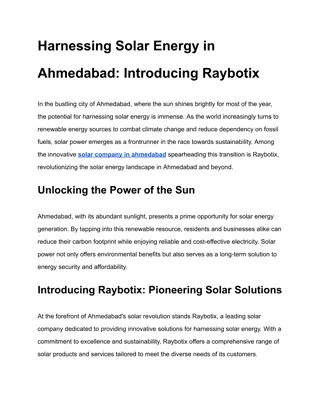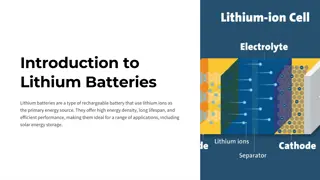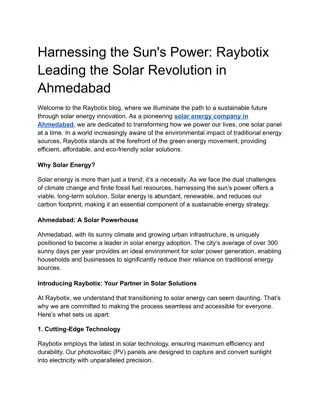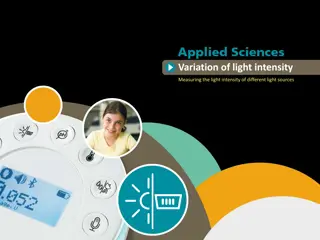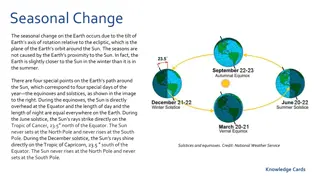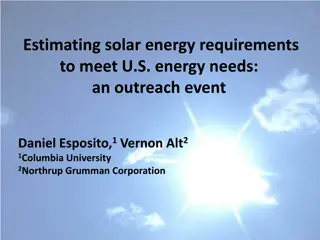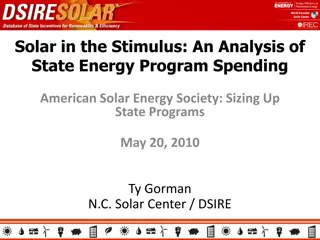Solar Intensity Prediction Model for Optimal Energy Utilization
This project proposal focuses on predicting solar intensity up to 48 hours ahead using a model that combines historical data and weather forecasts. By leveraging SVM regression, the model aims to optimize solar power generation for efficient energy consumption. Additionally, the project includes a consumption scheduler and cost-benefit analysis for solar panel installation, offering a comprehensive approach to sustainable energy management.
Download Presentation

Please find below an Image/Link to download the presentation.
The content on the website is provided AS IS for your information and personal use only. It may not be sold, licensed, or shared on other websites without obtaining consent from the author.If you encounter any issues during the download, it is possible that the publisher has removed the file from their server.
You are allowed to download the files provided on this website for personal or commercial use, subject to the condition that they are used lawfully. All files are the property of their respective owners.
The content on the website is provided AS IS for your information and personal use only. It may not be sold, licensed, or shared on other websites without obtaining consent from the author.
E N D
Presentation Transcript
PROJECT PROPOSALS FOR CS620 Rajdeep Sardar Mtech 2ndyear student, Department Of Computer Science & Engineering, IIT Bombay.
MTP Work: What IS Achieved Prediction of solar intensity up to 48 hours ahead of time RMSE is in range of 30~35%
OUR MODEL: COMBINE PAST DATA & WEATHER FORECAST Various Past Information [eg. Avg intensity at noon of same week and same month of previous years] Historical Data of Observed Intensity Historical Weather Forecast Data Build Train And Test Data Apply SVM Regression And Predict Solar Intensity n hours ahead [ n <=48] Reference [5]
Road Map Predicting solar power generation over a period in a solar power plant or rooftop solar panel Collecting historical solar generation data Fitting a model to predict the solar power generation in panels in that region.
Project : Consumption Scheduler Total Number Of Appliances Appliance Ratings Customers Electricity Requirement [eg. Wants to wash clothes today] Provide a hour wise Optimized Schedule for the day minimizing cost Electricity tariff Slabs with consumption Customer s Schedule Of Day [week day or weekend, working hours etc] Probable Solar Power Generation
Project : Solar Panel Cost Benefit Model Other Initial Investment Cost [battery, inverter etc] Maintenance Cost Over the lifetime of panel [including extra batteries] Solar Panel Cost A Tool Providing Cost Benefit Analysis For Installing The Panels Probable Solar Power Generation in the lifetime of panel Electricity tariff Slabs with consumptio n Customer Consumption Profile
REFERENCES [1] http://scikit-learn.org/stable/. [2] Cody A. Hill, Matthew Clayton Such, Dongmei Chen, Juan Gonzalez, and W. Mack Grady. Battery energy storage for enabling integration of dis- tributed solar power generation. In 2011 IEEE International Conference in Smart Grid Communications (SmartGridComm), pages 528 533. IEEE, 2011. [3] A. Kansal, J. Hsu, S. Zahedi, and M. Srivastava. Power management in energy harvesting sensor networks. In Transactions on Embedded Computing Systems, 2007. [4] D. Noh, L. Wang, Y. Yang, H. Le, and T. Abdelzaher. Minimum variance energy allocation for a solar-powered sensor system. DCSS, 2009. [5] N. Sharma, P. Sharma, D. Irwin, and P. Shenoy. Predicting solar generation from weather forecasts using machine learning. In 2011 IEEE International Conference in Smart Grid Communications (SmartGridComm), pages 528 533. IEEE, 2011. [6] Navin Sharma, Jeremy Gummeson, David Irwin, , and Prashant Shenoy. Cloudy computing: Leveraging weather forecasts in energy harvesting sen- sor systems. In 2011 IEEE International Conference in Smart Grid Communications (SmartGridComm), pages 528 533. IEEE, 2011.







